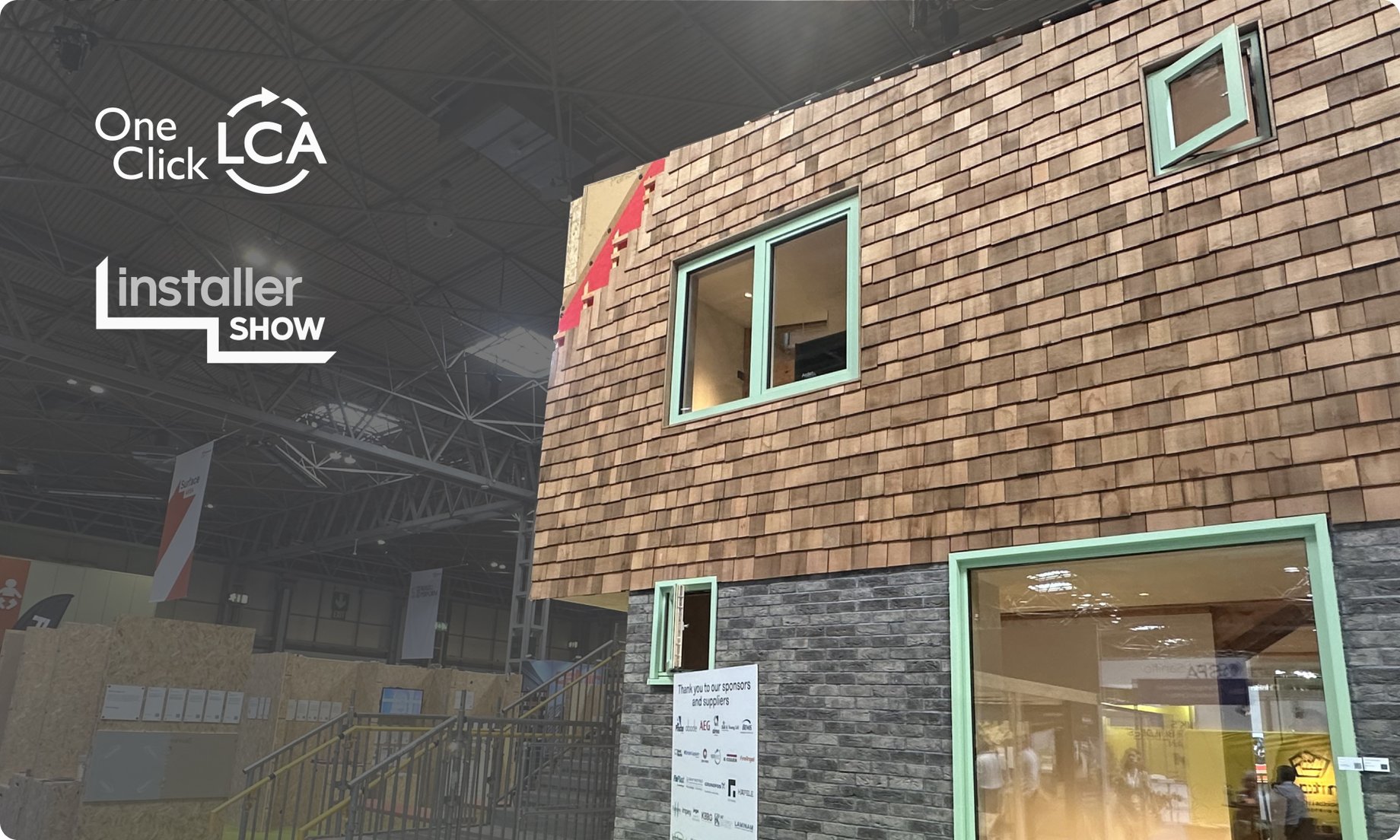If your product isn’t being selected for specification and procurement, it might not be because of price, quality, or even availability — it could simply be the absence of data.
That’s one of the most critical lessons to emerge from the HAUS project at Installer Show 2025. This full-scale modular home, constructed live on-site and assessed using One Click LCA’s advanced life-cycle assessment tools, offered a rare, real-world look at the embodied carbon performance of construction products. The findings revealed more than just a commendable 24% reduction in carbon compared to the UK LETI benchmark. They provided a sobering reality check for manufacturers: no environmental product declaration (EPD), means no visibility, and no sale.

Visibility is everything — and generic data is a liability
The HAUS project modelled 85 individual construction products. Of those, just 13 had product-specific EPDs. The remainder were filled in with conservative generic data points, which by design tends to overestimate environmental impact.
This isn’t just a modelling artefact — it’s a commercial disadvantage. Generic product data can make products appear more carbon-intensive than they are, and when specifiers are selecting products to meet tight carbon budgets, they will naturally favour those with verified, specific, and transparent data.
Backed by One Click LCA’s 2025 Carbon Experts Report, we know this isn’t speculation:
- 83% of AEC professionals say EPDs directly influence product choice.
- 89% of manufacturers acknowledge they’re losing business due to missing EPDs.

Carbon Experts Report 2025: Explore the insights from the annual LCA & EPD market report.
The HAUS LCA focused on A1–A3 stages (cradle to gate), covering raw material extraction, transportation, and manufacturing. With a total impact of 38,854 kgCO₂e (or 474 kgCO₂e/m²), it performed 24% better than the UK benchmark of 624 kgCO₂e/m², as defined by LETI.
5%201%20(1)%20(1).png?width=473&height=331&name=Installer%20Show_LCA%20Report_1%20(dragged)5%201%20(1)%20(1).png)
But the deeper value lay in understanding where carbon was hiding:
- 74.4% of emissions came from the external envelope — largely insulation and cladding.
- A material like wood fibre insulation, often assumed low-carbon, was a surprisingly high emitter in A1–A3.
- These insights would have been missed without quantified early-stage modelling.
Lesson for specifiers and designers: assumptions are risky. Only real LCA data reveals the true carbon cost of materials.
HAUS LCA: Download the life-cycle assessment of the HAUS to view insights
EPDs are a competitive advantage for manufacturers
It’s not just about meeting regulatory pressure — it’s about staying in the game.
The HAUS project showed that manufacturers with EPDs are far more likely to be selected, especially during early design when the largest carbon savings can be made. Beyond visibility, LCA is a powerful internal optimisation tool. Manufacturers routinely report 10–30% carbon reductions through product iteration informed by LCA data.
This aligns with the HAUS result itself: although only conceptual, the design used renewable materials like timber and biobased insulation to deliver a negative net embodied carbon impact when biogenic sequestration is included:
-46,478 kgCO₂e sequestered, vs. 38,854 emitted — resulting in a net impact of -7,624 kgCO₂e.

Regulatory landscape: EPDs are becoming a legal requirement
Across both the UK and Ireland, the regulatory momentum is clear — and accelerating.
The RIBA 2030 Climate Challenge targets 300–450 kgCO₂e/m² for new residential buildings — a threshold the HAUS design is already nearing, even at the conceptual stage and with minimal EPD data.
Meanwhile, the Greater London Authority’s Whole Life Carbon (WLC) reporting mandates detailed LCA submissions for major planning applications, setting a precedent many local authorities are expected to follow.
In Ireland, the Climate Action Plan outlines a national roadmap for decarbonising construction. A National Strategy for Sustainable Construction is currently in development, anticipated to introduce LCA and embodied carbon limits aligned with both UK benchmarks and EU law.
In the UK Parliament, Part Z — an industry-led proposal endorsed by hundreds of stakeholders — seeks to embed whole-life carbon assessment and reporting into the Building Regulations. Though not yet law, it signals growing consensus that embodied carbon must be addressed alongside operational performance. Part Z proposes:
- Mandatory whole-life carbon assessments for all major projects.
- Embodied carbon caps phased in by project type.
RICS (Royal Institution of Chartered Surveyors) has also taken a leading role in defining best practice. The RICS Whole Life Carbon Assessment for the Built Environment standard is already widely referenced in public and private procurement and underpins much of the UK’s voluntary carbon reporting. It provides a robust framework for LCA, aligned with EN 15978, and will likely become the basis for future regulatory requirements.
For manufacturers exporting to the EU, change is already legislated:
- From 2026, the revised Construction Products Regulation (CPR) will require product-specific, third-party-verified carbon data, including Global Warming Potential (GWP) values embedded in Declarations of Performance.
- These will form part of mandatory Digital Product Passports, driving transparent procurement and lifecycle tracking across the EU.
Compliance & market access: Find out why EPDs are critical for MMC manufacturers.
Further layers of compliance will come via:
- The Ecodesign for Sustainable Products Regulation (ESPR), mandating design-for-sustainability across product life cycles.
- The Energy Performance of Buildings Directive (EPBD), which will make LCA mandatory for whole buildings.
- The Carbon Border Adjustment Mechanism (CBAM), placing tariffs on high-carbon imports into the EU.
The clear takeaway: waiting for a client to ask for an EPD is too late. If your product isn’t verifiably in the system, it simply won’t be considered. Regulatory expectations are shifting from voluntary best practice to binding requirements — and fast. Now is the time for manufacturers to act.
What HAUS proves — and what manufacturers must do now
HAUS was more than a showcase home. It was a demonstration of how decisions backed by life-cycle data shape real-world carbon outcomes and procurement decisions.
Key takeaways:
- EPDs are no longer “nice to have” — they are essential for specification, compliance, and market access.
- LCA at concept stage enables major emissions savings and helps meet voluntary and mandatory carbon targets.
Manufacturers without verified data risk commercial exclusion and regulatory non-compliance.
Next steps for manufacturers
- Invest in product-specific EPDs — particularly for high-impact elements like insulation, cladding, and flooring.
- Use LCA tools early to inform R&D, refine material choices, and improve sustainability performance.
- Engage with platforms like One Click LCA to streamline EPD generation, integrate carbon data tools into your processes, find low-carbon materials, and meet upcoming digital passport requirements.
Carbon transparency is becoming the new baseline in product specification — not just in the UK and Ireland, but across Europe. Manufacturers who embrace LCA and EPDs today position themselves as partners in climate performance. Those who don’t may find themselves left out of the next project, regulation — or market.
Data drives specification. It’s time to make sure your product is visible.
Tip: learn from market leaders
Learn how IJM Timber Engineering is using timber frame and MMC to deliver low-carbon housing 30% faster in Ireland. Progressive manufacturers are reducing, reporting, and verifying their carbon. Learn how Stubbe Precast cut 14.6% carbon emissions in its products, while Genuit Group optimised its MEP products saving 45,000t of CO2e.
Carbon Experts Newsletter
Industry news & insights — straight to your inbox
Want to learn more?
Asha Ramachandran • Apr 24 2024
Aileen Carroll • Sep 26 2024
Laura Drury • Sep 03 2024
